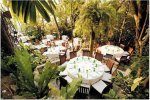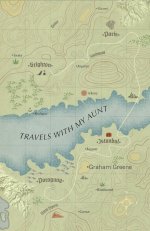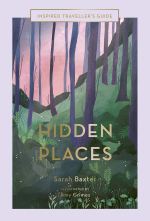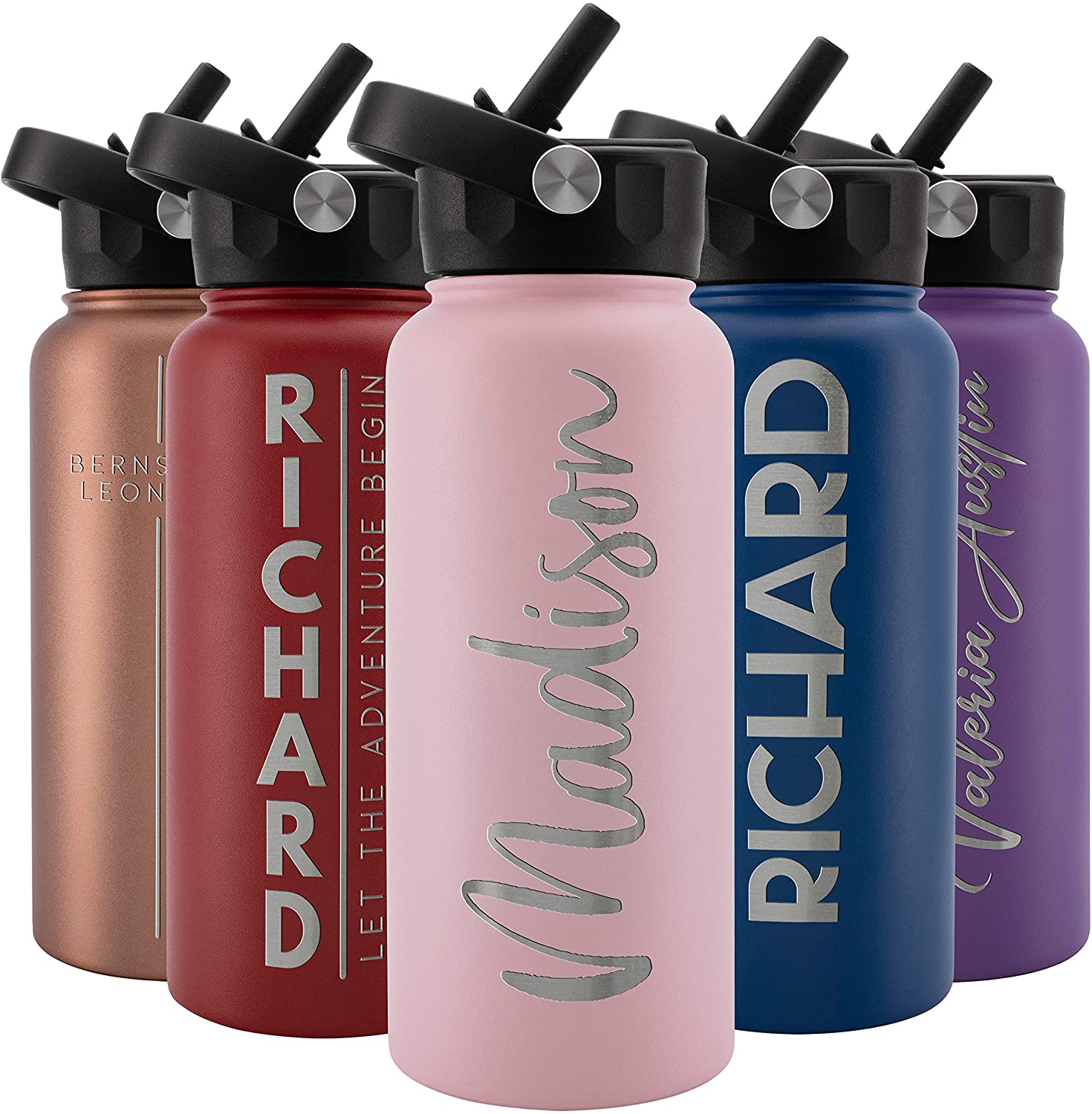Cruising Burgundy France
Cruising Burgundy France - cruising on the Canal du
Nivernais in Burgundy.
Reflected sunlight from the water outside dances on the chestnut ceiling of my cabin the first morning I awaken aboard the luxury barge La Belle Époque. I get up to look out the open porthole window and am greeted with a friendly squawk. A large white swan approaches expectantly, followed by several mallard ducks. We are eye level with each other. Having no bread to offer, I quickly close the window.
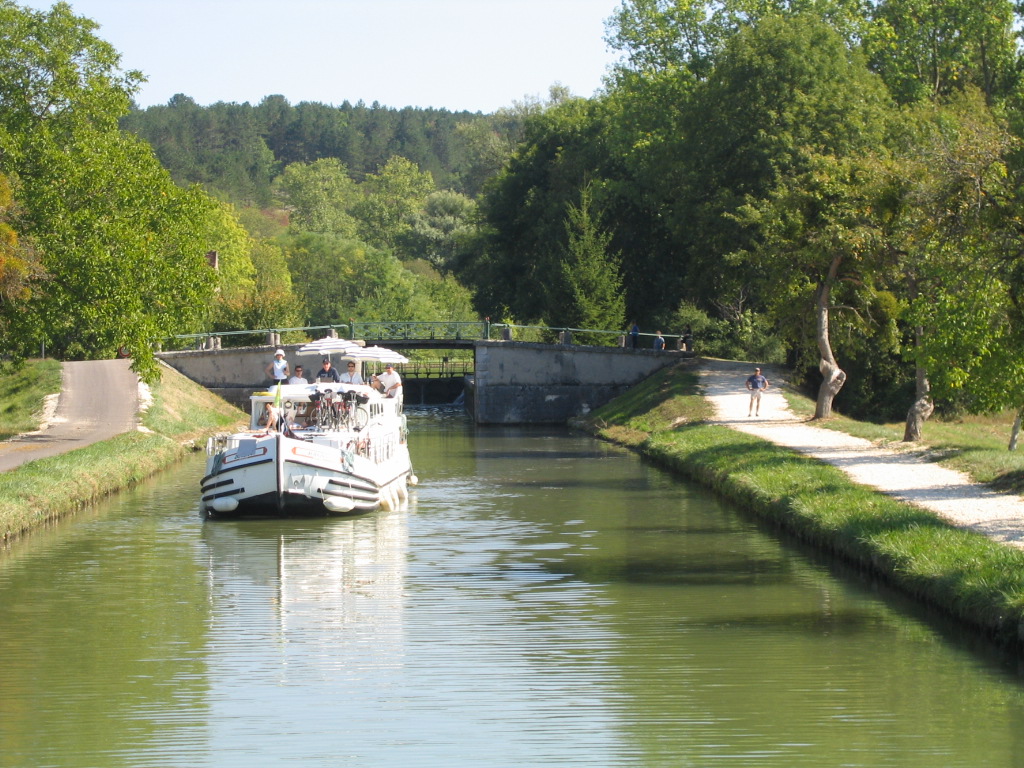 Canal du Nivernais
Canal du NivernaisCruising Burgundy France
After a
shower in the tiled bathroom and rub-down with a thick nautical blue towel, I
head upstairs. On an antique oak sideboard in the main salon hostesses Fanny
and Barbara have laid out a breakfast of granolas, yogurt, and fresh fruit.
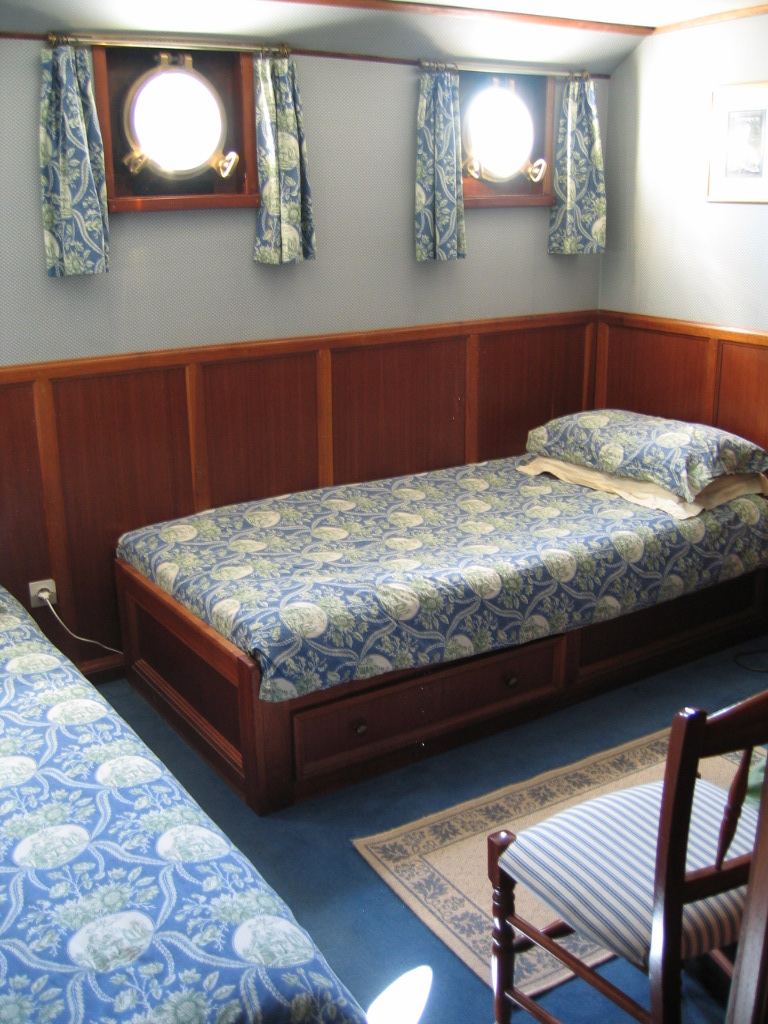 Our cabin
Our cabinWhile I was still gazing at the ceiling of my cabin, Captain Lee had been in the village of Auxerre buying fresh baguettes, croissants and pain chocolate.
Cruising Burgundy France
La Belle Époque is one of several luxury canal barges operated in France by European Waterways. Once a working canal barge, it has been redesigned with both elegance and passenger comfort in mind.
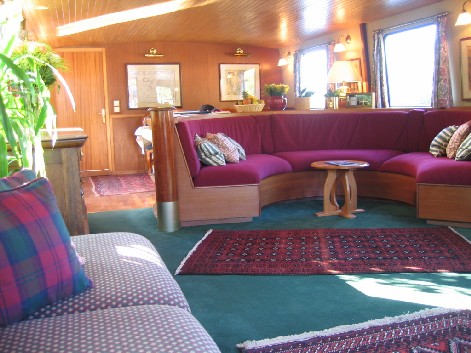 The Salon
The SalonThe salon is hunter green, rose and mahogany, with comfortable banquettes and vases of fresh flowers. There are a sun-deck, Jacuzzi spa, sauna, fitness studio, and bicycles for guests to ride along the canal paths.
It’s a fine Autumn day in France, still summer in the afternoons, with nights that offer a crisp reminder of winter to come. This state-of-the-art hotel barge carries just twelve passengers, with six crew members to take care of every possible passenger need.
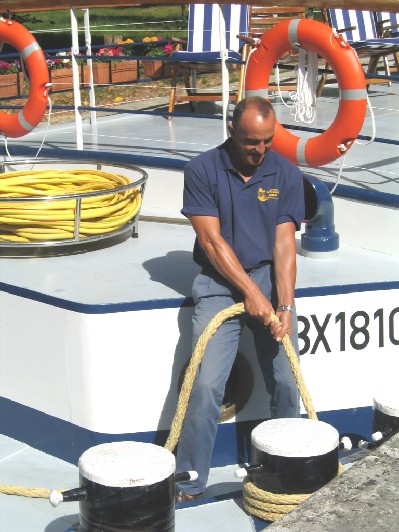
Nick, our guide, had picked us up in Paris the previous day in front of the Hotel Ampère. A two-hour journey by minivan through rolling French countryside had brought us to the medieval town of Auxerre, where La Belle Époque and her crew awaited.
Cruising Burgundy France
We enjoyed a champagne welcome accompanied by freshly-baked popovers. After meeting the crew and getting settled into our cabins, we explored the cobblestone streets and fashionable shops of Auxerre.
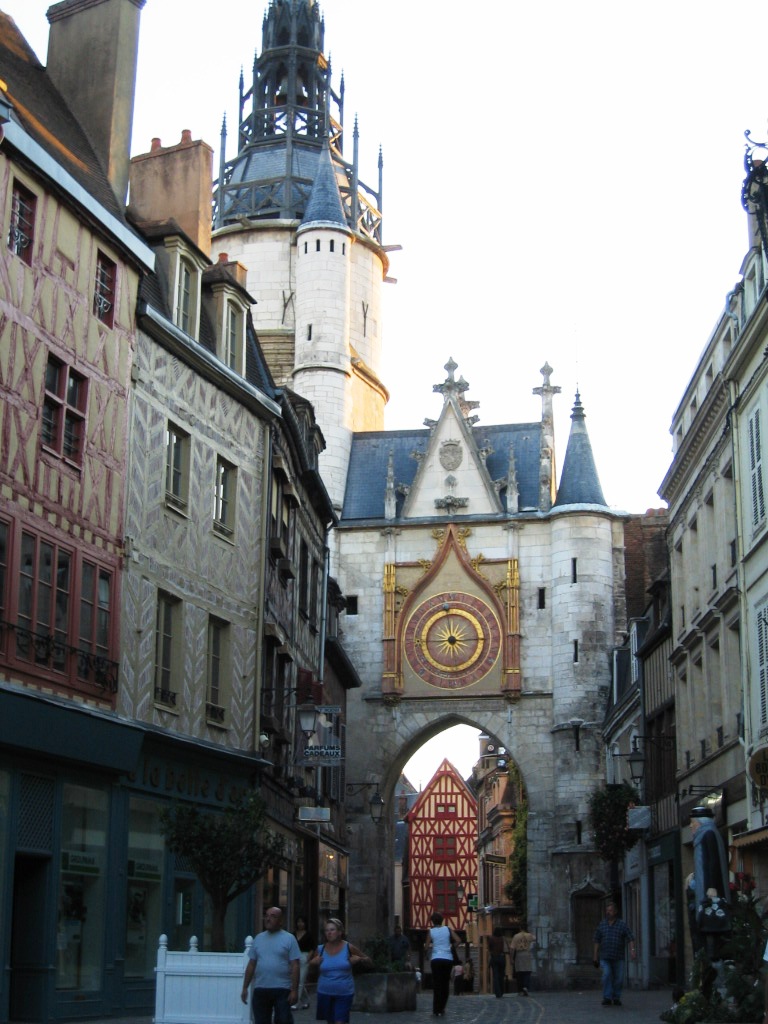 At the junction of the Canal du Nivernais and the River Yonne, Auxerre was a pivotal town on the ancient north-south road through France.
At the junction of the Canal du Nivernais and the River Yonne, Auxerre was a pivotal town on the ancient north-south road through France.Auxerre was a big market town for lumber and wine as well as an important spiritual center. Surrounded by timber-framed buildings are a 15th century tower with a large decorative 17th century clock.
Our first dinner aboard La Belle Époque introduced the talents of chef Guy. ‘Scallops Mating with Snails’ followed by a charolet filet with red pepper pure and potatoes gratine au dauphin.
Desert was shortbread with raspberry coulis. A white St. Veran and a red Aloce Coton (wines of the Burgundy area) accompanied the meal, and we discovered there is no limit to the number of bottles we may consume.
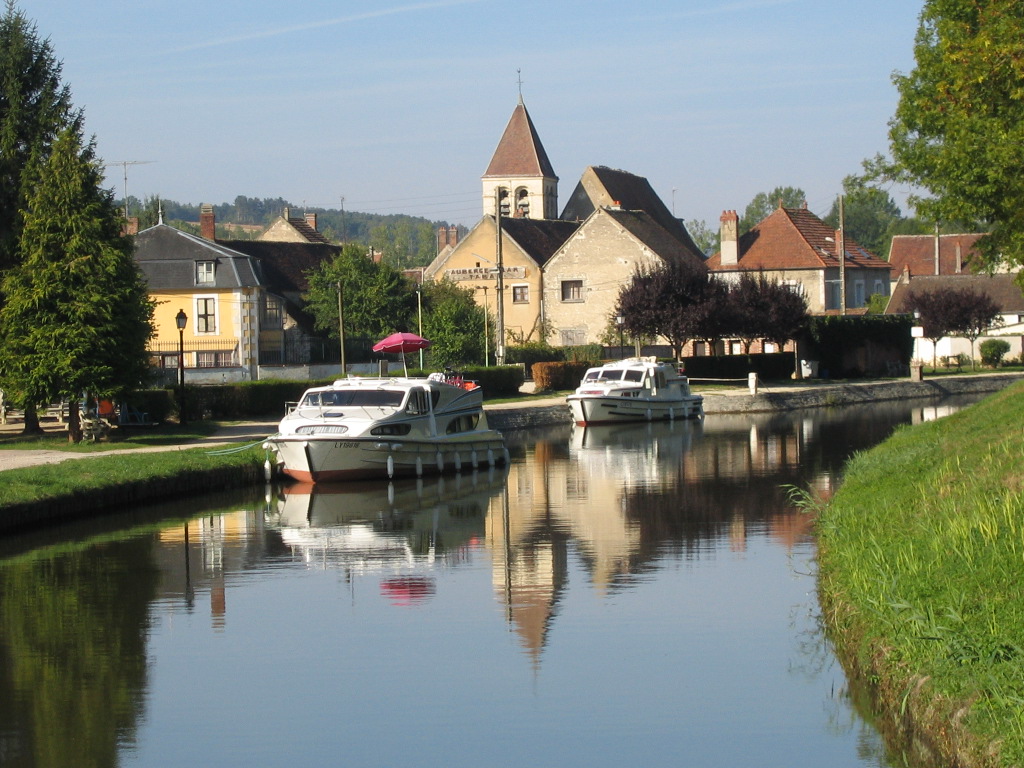 Monday morning, about “tenish”, La Belle Époque glides gently away from the Auxerre waterfront.
Monday morning, about “tenish”, La Belle Époque glides gently away from the Auxerre waterfront.Before
the week is ended, we will travel through 31 locks to the town of Clamecy.
Barge speed is limited to 3 mph on the canals and 10 mph on the rivers.
Cruising Burgundy France
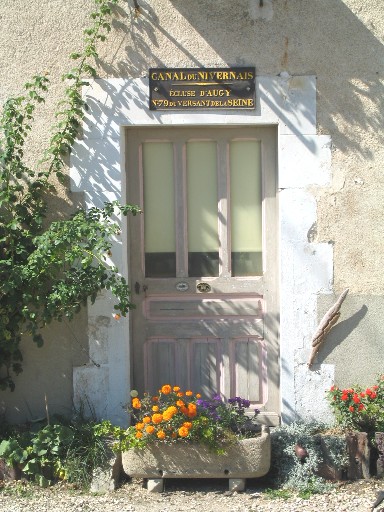
La Belle Époque slides into a chamber to rest while a set of gates at each end closes so that the water level can be raised or lowered. Potted flowers and a picturesque stone house indicate where the éclusier—lock keeper—lives. At Captain Lee’s call he comes out to manage the gates.
Timing is important, however. If we arrive while the éclusier is at lunch we will just have to wait. The French take their déjeuner very seriously.
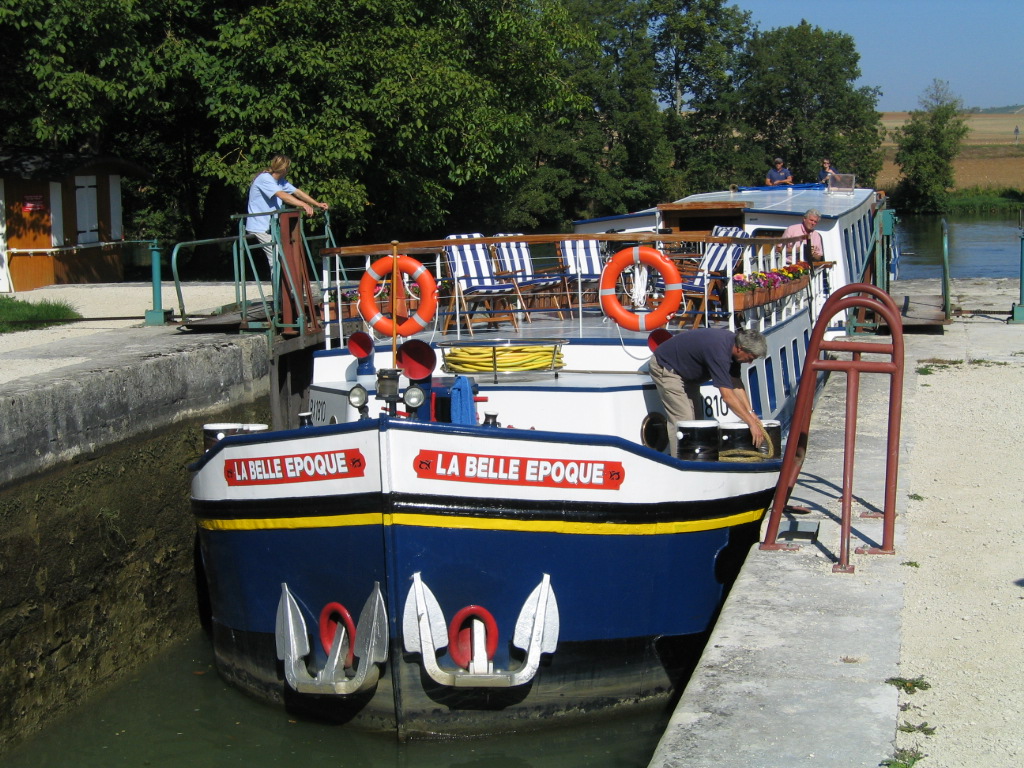 Soon we reach our first écluse or lock
Soon we reach our first écluse or lockIn France there are over 2,700 miles of inland waterways including a 750-mile network of connecting canals.
Cruising Burgundy France
Many locks are hundreds of years old. Most canals were built in the 19th century, but some are two centuries older. They were built to accommodate only the width of the barges, so often there is barely a three-inch allowance on each side of the barge.
Because canal barges were originally horse drawn, poplar trees were planted along the way to protect the horses from the sun.
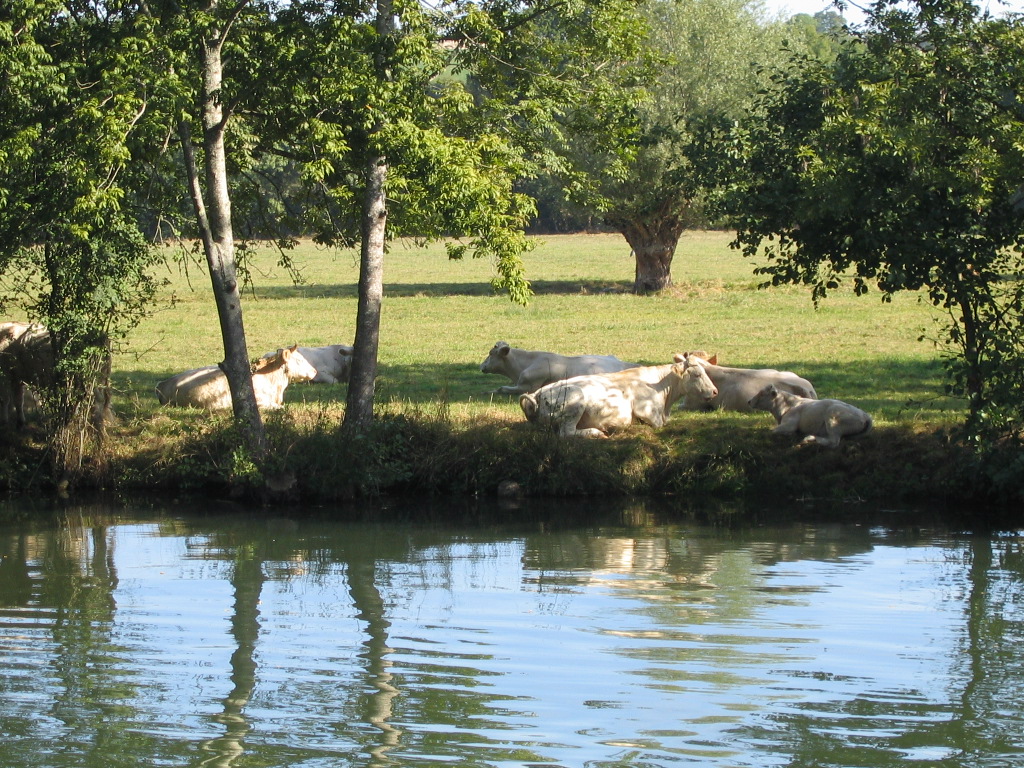 Charolais cows rest in a pasture along a canal.
Charolais cows rest in a pasture along a canal.The Canal du Nivernais passes through western Burgundy, crossing the Yonne Valley and sometimes merging with the Yonne River itself. It was originally built to transport wood from the Morvan forests to meet the firewood demands of Paris.
This wood trade was the main source of income for this area until the 1920s.
The canal saw the last of its merchant traffic in the 1970s.
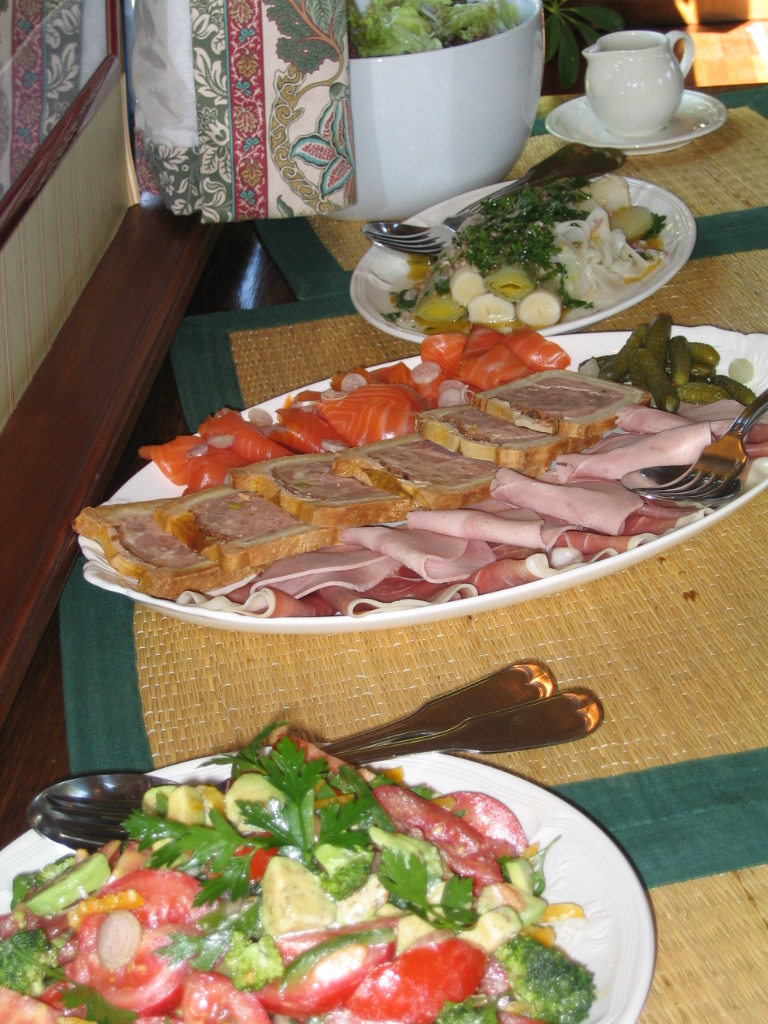 A gourmet lunch in the Salon of La Belle Epoque
A gourmet lunch in the Salon of La Belle EpoqueAs we glide by a rolling patchwork of green hills and picturesque vineyards, lunch is served: quails in crème frache sauce, tuna pasta salad, caprisi salad, fruits, a white Savignon St-Bris and a red Chitry. There are two kinds of cheese with exotic names—Delice de Bourgogne and St. Mair de Tourraine.
Cruising Burgundy France
After lunch there is another lock, and while the barge rests we pile into European Waterways’ minivan. Nick takes us to St-Bris le Vineux, a little wine village above a network of medieval passages.
At the stone farmhouse (complete with satellite TV dish) of Monsieur Bersan, we descend into an ancient cave for a wine-tasting.
The cool air is strongly scented with damp, wet wood and thriving mold.
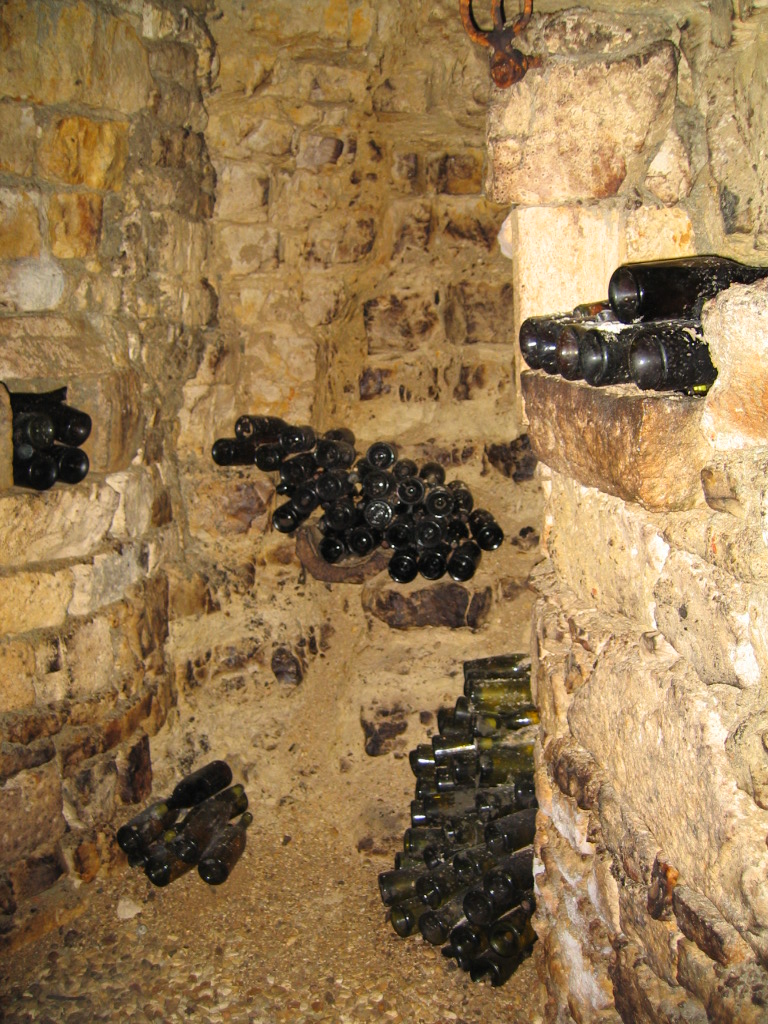 Everywhere there is a flat surface, wine bottles lay in horizontal slumber.
Everywhere there is a flat surface, wine bottles lay in horizontal slumber.“This is the only place in Burgundy where sauvignon blanc is grown,” explains Nick. “All white wines are made from chardonnay grapes, all red wines are made from pinot noir grapes.”
We learn that St. Vincent is the patron saint of winemakers and that during World War II a monk named Kir invented the wine drink of the same name.
“Wherever you find wine, you’ll find monks,” says Nick. “When they came here in the 4th and 5th centuries they needed wine for mass, so they began to plant vineyards.”
Many of France’s vineyards today were planted and producing by 50 BC. The quality and strength in alcohol content changed dramatically with the invention of the cork in the 18th century making it possible to age wine in a bottle.
Burgundy produces two of the most popular wines in France: Beaujolais and Chablis.
Nick says, “The way to remember how to hold the bottle is to remember the mistress and the wife: the champagne bottle is the mistress so you hold her by the bum, and the wine is like the wife, so you hold her by the neck.”
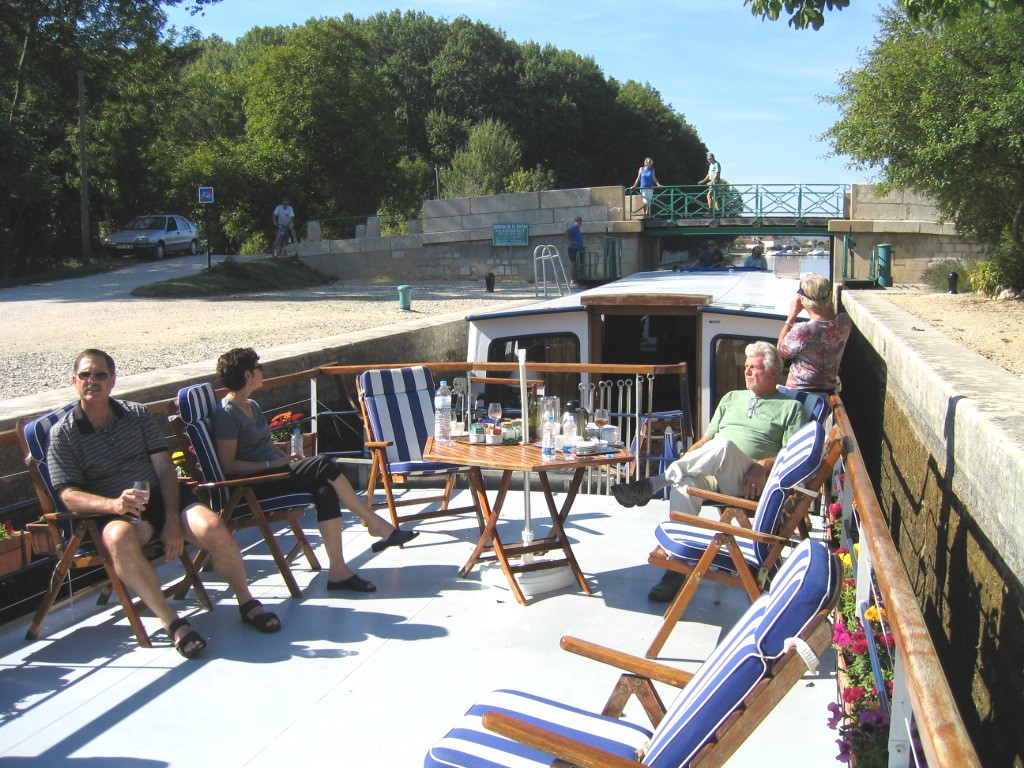
La Belle Époque rests for the night near the neighboring village of Vincelles. As we drink kirs outside on the deck, someone says, “It’s eight-ish, must be time for dinner.”
Tonight Guy has prepared vanilla-scented lobster in vol au vent cups, a white fish with saffron rice, followed by a selection of cheeses and orange and lemon-flavored roasted peaches.
With our dinner we are served two of the best wines of the area: a white Perand-Vegelesses and a red Savigny-les-beaune. Cheeses are Langres and Camembert.
Fanny says,
“This is a buttery cheese created for Napoleon by a lady in the Norman village
of Camembert. ”I’m on deck early Tuesday
morning to sip coffee and watch the sun rise above the treetops. Church bells
ring in a distant village. Ribbons of mist laze above the glass-like surface of
the canal.
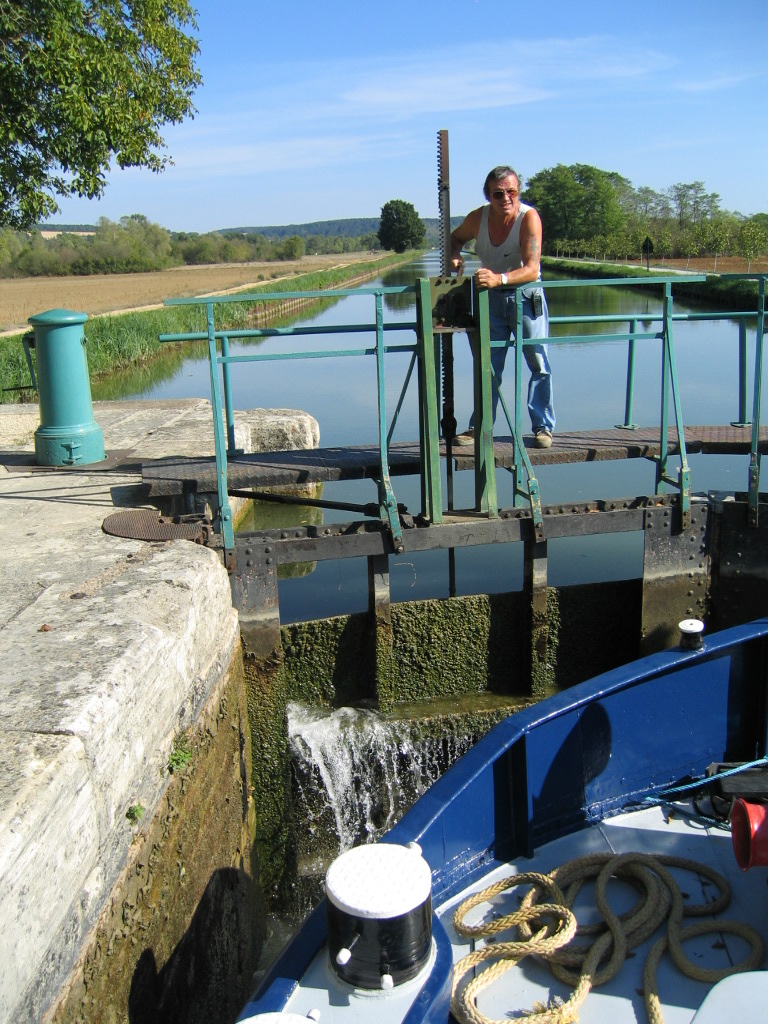 A French eclusier watches as the lock fills with water to take our barge further along the canal.
A French eclusier watches as the lock fills with water to take our barge further along the canal.While we leisurely breakfast, La Belle Époque makes her leisurely way towards the next lock. About “tenish” Nick takes us to shop in Auxerre, just a few minutes away by van.
At lunch we write down the exotic names of our cheeses, Pont-lveque and Crottier de Chaugnol, and wines, a white Bersan Cote’D’Augere and red Epinaul.
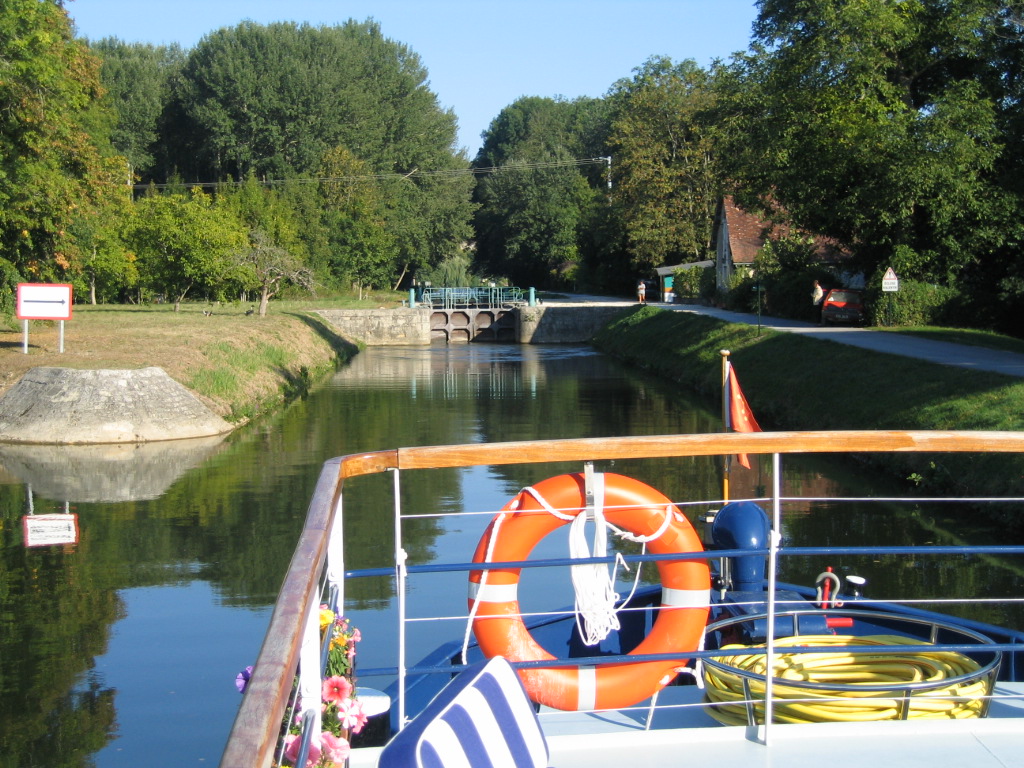
We are no longer counting the locks as we pass through them; there are simply too many. Barges have played a major role in France’s economy for centuries, transporting both goods and people. Barges navigate well in shallow water, able to go anywhere there is three feet of water or more.
“If you sat on this river, in a week you’d float to Paris,” says Captain Lee.
Tuesday evening we are taken out for dinner to Auberge de la Fontaine in Accolay. The restaurant is in an old cave, its curved brick walls and ceiling painted white and glowing warmly from the illumination of several torcheres.
The village is quiet at night, but the auberge is lively, dinner is superb and we enjoy a white Pernand-vergelesses and a red Savigny-les-beaune.
On Wednesday we discover that on the shelves behind a banquette are games, a small library of novels, and a CD player. Music choices include Joe Cocker, Jimmy Buffet and Ravel’s Bolero.
After lunch we visit another historic French village, Vzelay. A hilltop town and Christian shrine, this was the site of the Call to the Second Crusade by St-Bernard in 1146. Dominating the town is the 12th century Roman Basilica of St. Mary Magdalen.
Regarding its spirituality, it has been written that “One comes to Vzelay as towards a star.”
This was the gathering place for the Knights Templar. The ‘logo’ of the city is the scallop shell, signifying their patron saint, St. Jacques.
“This is the origin of the name of the famous scallop dish, Coquille St. Jacques,” says Nick.
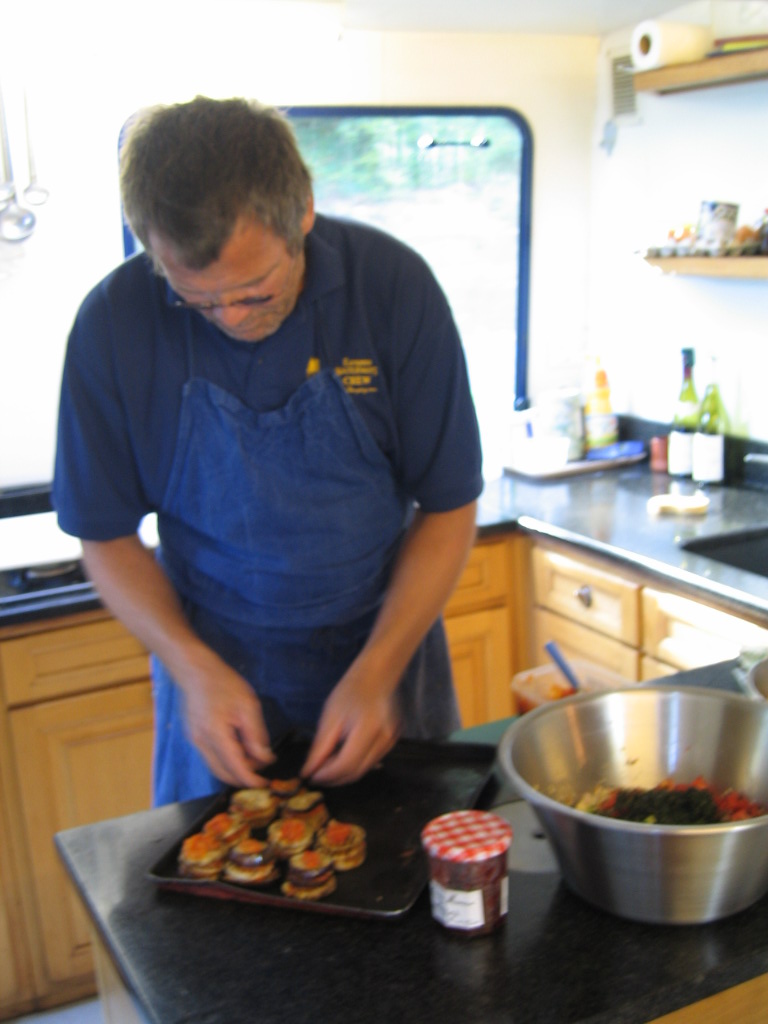 Chef Guy prepares another gourmet dinner.
Chef Guy prepares another gourmet dinner.There’s just enough time for a nap before another of Guy’s formidable dinners: escargots de Bourgogne, guinea fowl with wild mushrooms, three cheeses and summer fruits cooked in a creamy almond sauce, accompanied - naturellement - by a white Vezelay-les-Clos and a red St. Aulein.
The sun is so warm, the food so satisfying, and the wines so flowing, that by Thursday morning (“What? No wine with breakfast?” someone jokes) we are too mellow for words.
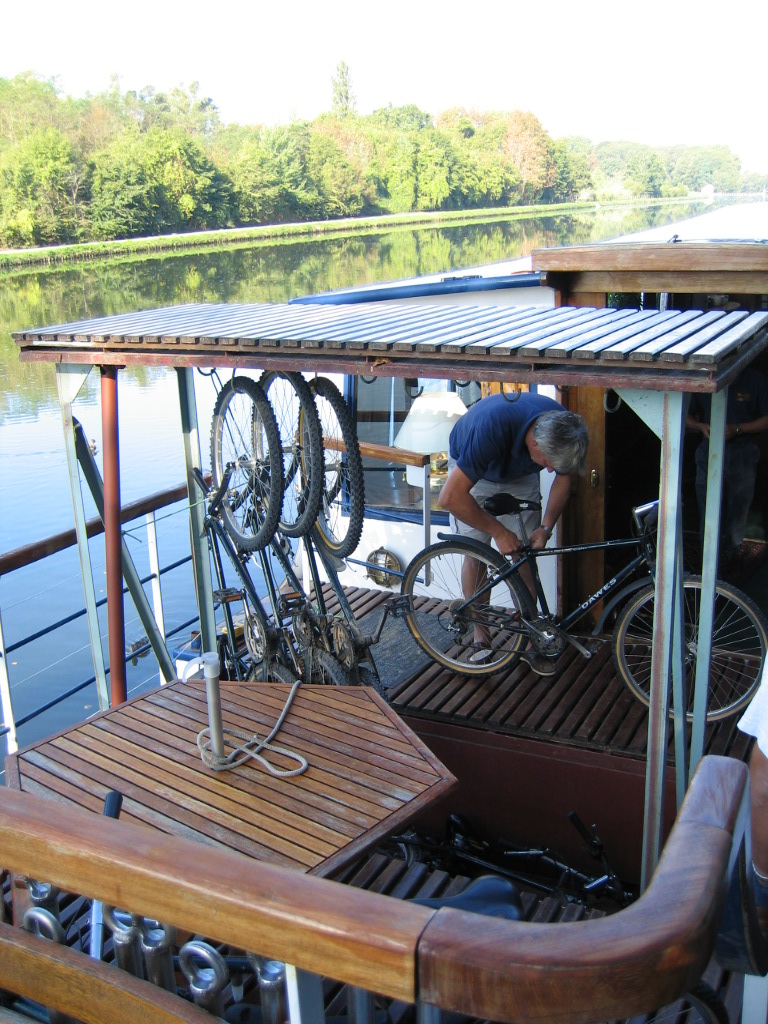 A section of the deck elevates to expose the bicycle storage.
A section of the deck elevates to expose the bicycle storage.The bicycles are brought out from below deck for a ride along the canal as we cruise past woodlands and pastures and pass through more locks.
Guy presents two kinds of quiche and two kinds of salad for lunch, along with more cheese and more wine. The cheese called La Pierre que Vivre (the stone that lives) is worth noting, otherwise we are too laid back to make food and wine notes.
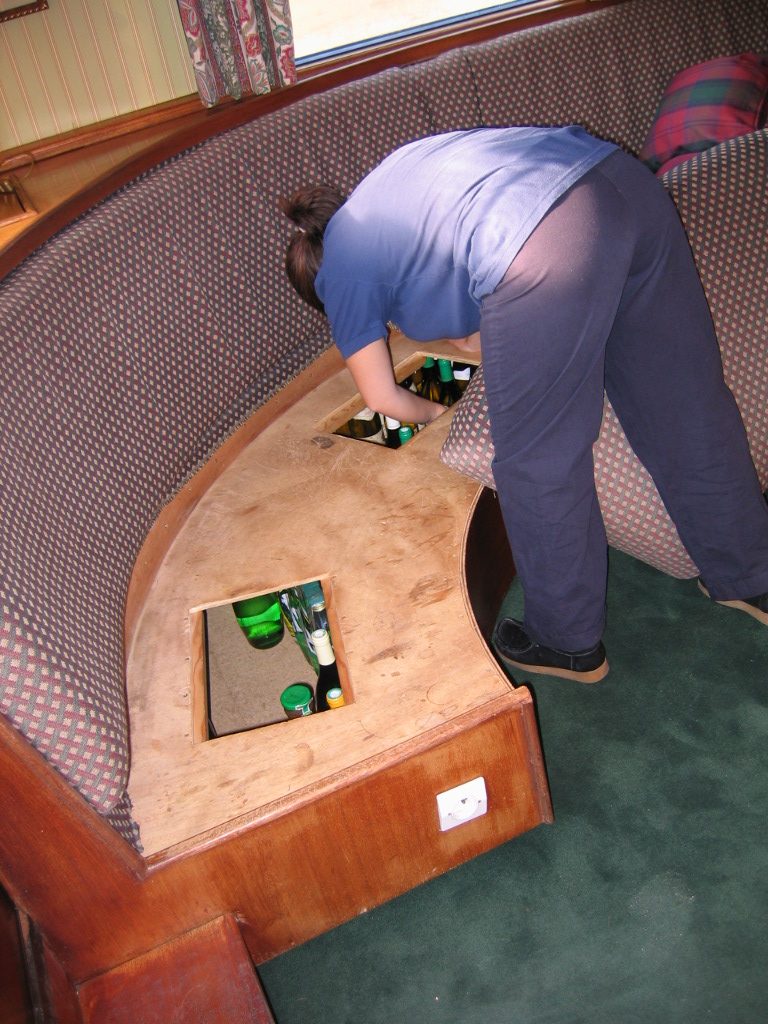 Fanny peruses the wine stock.
Fanny peruses the wine stock.We discover where all this wine is coming from: Under each banquette in the salon stand about a hundred bottles of wine. Shouldn’t they be resting on their sides?
“Mais non,” replies Fanny. Perhaps because we drink it up so fast. . .?
The afternoon is hot hot, and I doze below (it’s cooler in our cabin) until our arrival at Lucy-sur-Yonne, where La Belle Époque moors for the evening. Nick takes us off in the (air-conditioned) van to visit La Ferme de Misery (pronounced ‘mee-zair-ay’).
This real French farm, dating from 1850, is where ducks are raised for foie gras. The origin of foie gras goes back to Egyptian times.
The Egyptians noticed geese would eat everything before their migration and the liver at this time was particularly tasty, so they began feeding corn and figs to their geese.
The ducks we meet today are nine weeks old, all male. The females go elsewhere to be raised for roasting. These ducks will next be hand-fed.
“Men are better for hand-feeding because they can communicate with the duck,” we are told. “Women are busy multi-tasking in their heads and can’t focus as well.”
Fois gras, 100 percent duck liver, is rich, but not particularly fattening. Paté has pork in it. What you want to buy is foie gras du canard entire, we learn.
After stuffing ourselves with fois gras (accompanied by a little white wine) we face another of Guy’s culinary extravaganzas: risotto and a pork filet mignon in mustard sauce, two cheeses, two wines, and homemade ice cream with a raspberry sauce.
“I can’t eat another thing. . . ,” murmurs a guests. “Well maybe just a bite.”
Our last full day aboard La Belle Époque is peppered with mutinous comments: “We could arm ourselves with empty wine bottles, and take over Guy’s kitchen.” No one wants this idyllic week to end.
In the morning Nick takes us into the countryside where there is a thousand-year-old road of iron ore rock. It leads deep into the woods to an old roman ferier from the first century. The foundation remains of the Roman administrator’s house are still in place.
Lunch on Friday is two salads, a ratatouille of eggplants and peppers, and sliced roast pork. The cheeses are Larquetot and St. Felician.
All is washed down with a white Pouilly Fume and a red Coulanges. The saying that the Holy Trinity of the French table is wine, bread and cheese is well-founded.
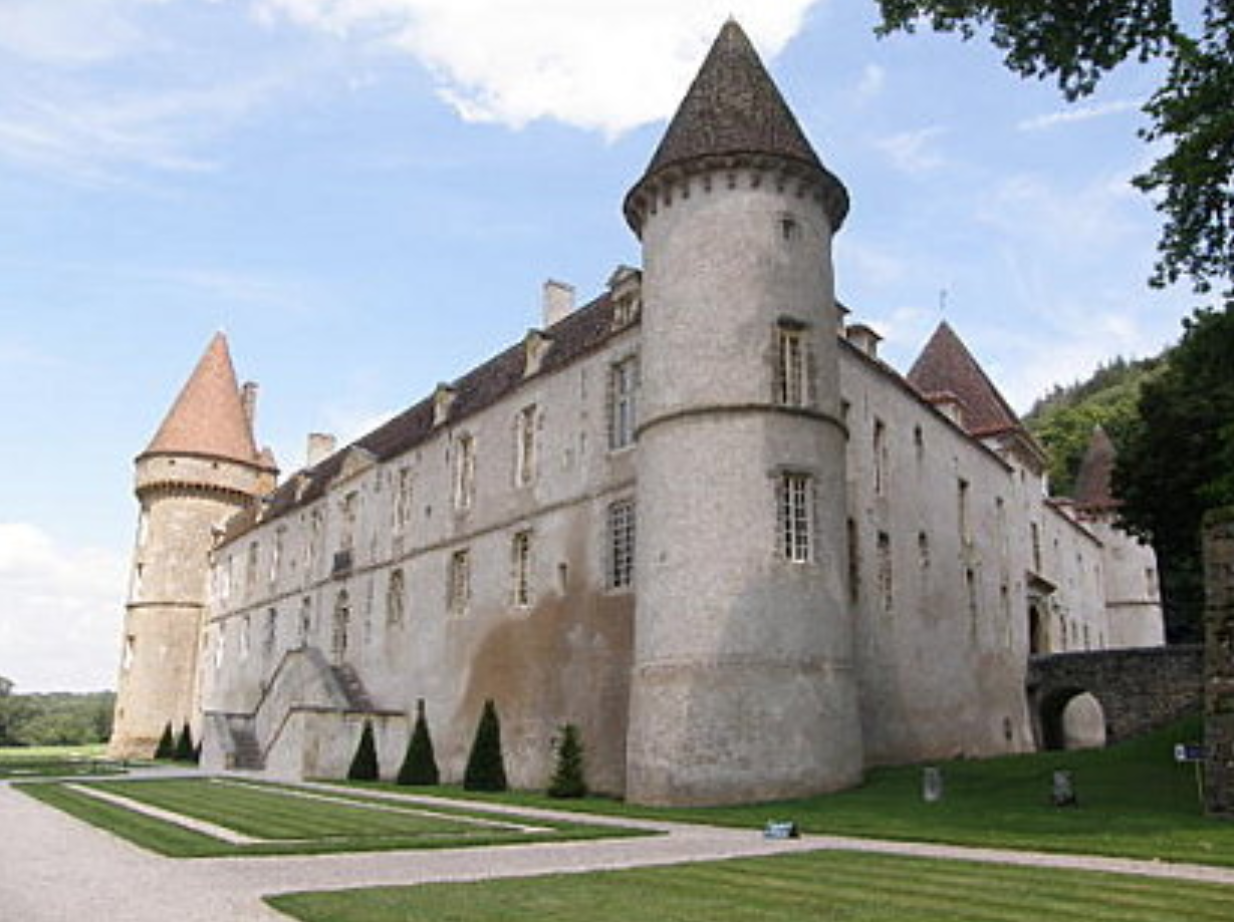 The medieval castle, Chateau de Bazoches.
The medieval castle, Chateau de Bazoches.After lunch we visit Chateau de Bazoches. Elevated on a wooded hill, Bazoches is a 12th century medieval stronghold, adopted in 1675 by Marshall de Vauban, Louis XIV’s great military engineer, master of sieges and military architecture, and the founder of Civil Engineering. Through a marital quirk of the family tree, the chateau is still owned by descendants of Vauban.
Marshall de Vauban was a forward-thinking man. He was the first person to use statistics to prove points and he invented the iron cannonball. He wrote the first book on pig-farming.
One of his less celebrated writings is a treatise in which he presented the novel idea that taxes should be paid according to the amount of one’s income─a higher percentage for the rich and lower percentage for poorer people.
In Marshall de Vauban’s bedroom, richly decorated with carved furniture, paintings, tapestries and trompe l’oeil, Nick says, “The beds are short not because people were not tall, but because they slept propped up on pillows—it was believed that if you slept flat, you could die in your sleep.”
Nick presents history full of anecdotes sprinkled with humor. Here we learn the origins of the phrases, “the stinking rich” and “so cold it’s freezing the balls off a brass monkey.”
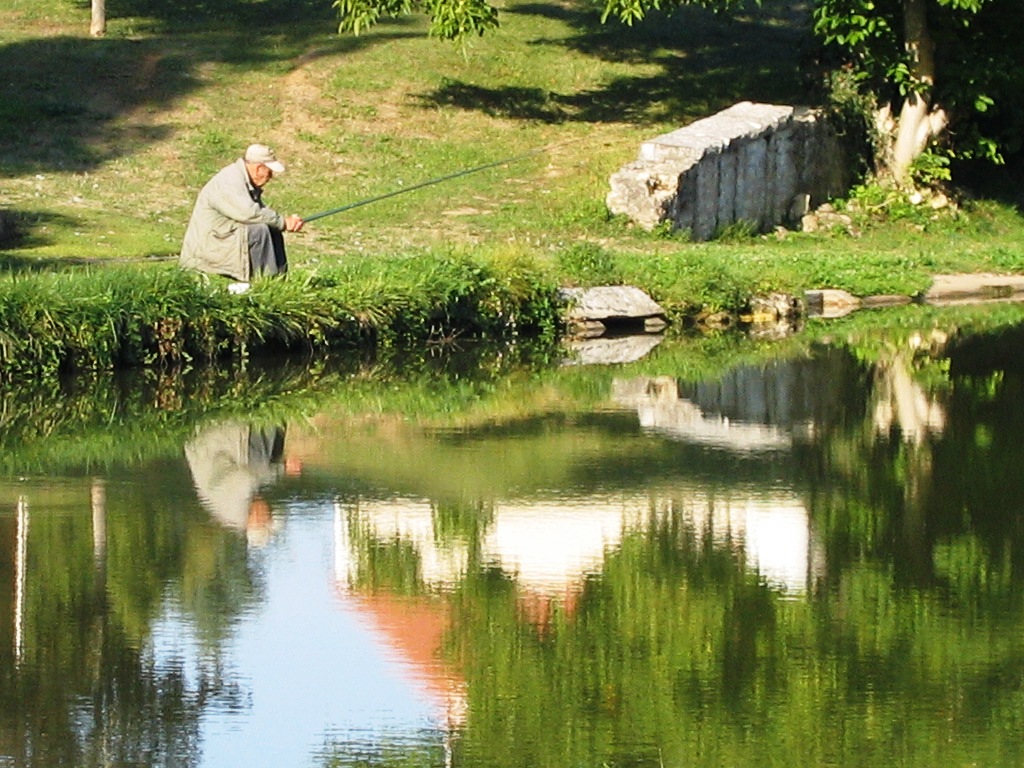 A French fisherman takes advantage of a beautiful fall day along the canal.
A French fisherman takes advantage of a beautiful fall day along the canal.La Belle Époque approaches Clamecy, where the waterway alternates between the Nivernais canal and the Yonne. Clamecy has been described as “a town of beautiful reflections.”
It’s an old medieval fortified town, and the center of the 19th century logging industry. We’ve arrived at the end of our watery road.
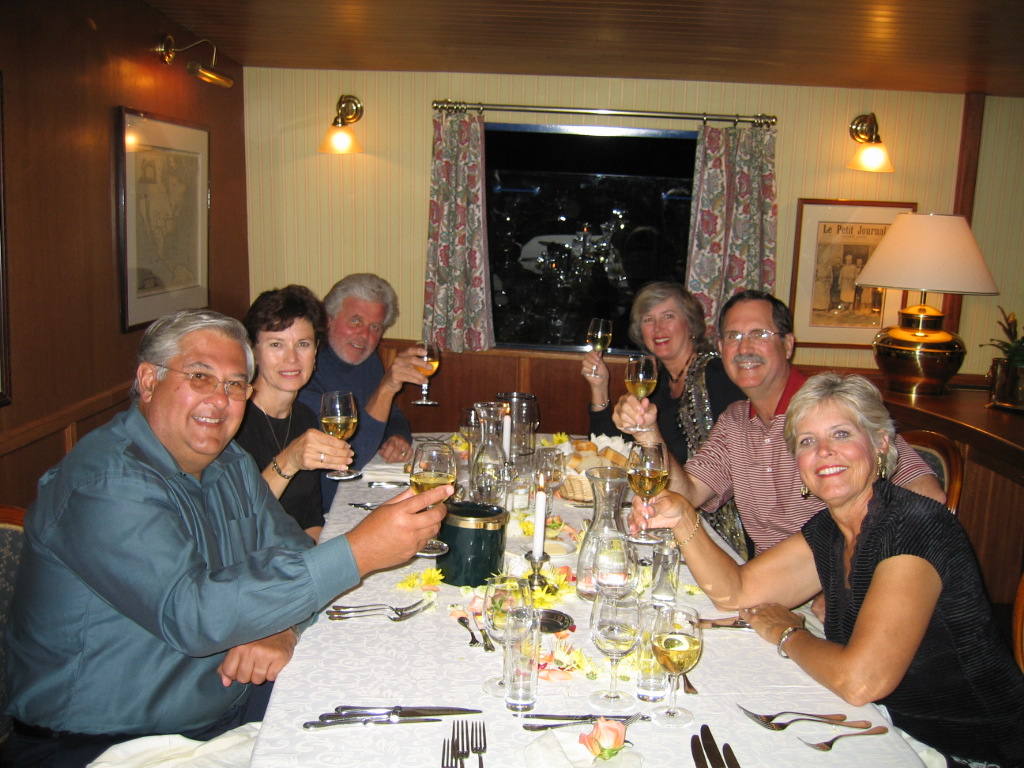 We are ready to eat — yet again!
We are ready to eat — yet again!Friday night is the Captain’s Dinner. While considered a dress-up affair, we are a small group and feel more casual. For this occasion, the men wear slacks instead of shorts, the ladies wear skirts instead of shorts, and all our clothes are clean. Captain Lee joins us at the head of the table.
Barbara and Fanny, also in dresses for the occasion, have arranged a formidable table. Napkins for the gentlemen are folded to resemble a tuxedo front, and napkins for the ladies are folded to resemble a large rose.
Wine and water goblets sparkle warmly from reflected candlelight. The white wine is a Chablis and red is a Vosne Roman. Cheeses are Epoisses and Roquefort.
Between churches, cheeses, museums, momentous meals, wines and caves, this has been a week of sensory overload.
La Belle Époque has only traveled 40 miles. Passing through the hills of Morvan, the wild valley of the Yonne, and the green meadows of Bazois, the Canal du Nivernais is one of the most beautiful canals in France.
“Roll us carefully off this boat . . .,” murmurs a guest at our departure the following morning.
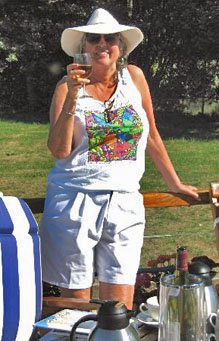
A special thanks to ‘barge mates’ Bev and Kathy for making meticulous notes of the cheeses we ate and the wines we consumed while I was distracted by eating.
--story and photos by Carolyn V. Hamilton



